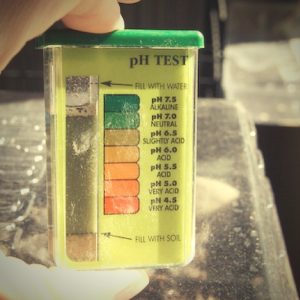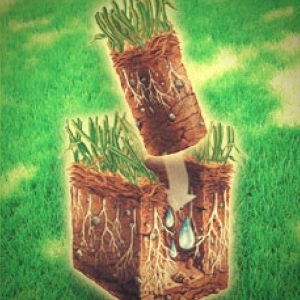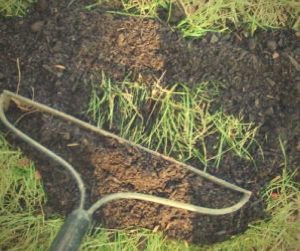Soil Preparation for Your Lawn
The foundation of a good lawn is its soil type. Without the ideal soil type – and that’s loam – it would be difficult for you to create and maintain a beautiful lawn.
Conducting a Soil Test
 The first step you should take is conducting a soil test to know if your soil type is loam and not anything else. There are basically four types of soil: clay, sand, silt, and of course loam. You can guess the type of soil your garden has just by gathering a handful.
The first step you should take is conducting a soil test to know if your soil type is loam and not anything else. There are basically four types of soil: clay, sand, silt, and of course loam. You can guess the type of soil your garden has just by gathering a handful.
If the soil in your hand is clumped together tightly then it’s most likely clay. If you squeeze it and the soil feels rough and seemingly filled with bits and pieces then it’s most likely sand. If, on the other hand, the mixture feels too smooth and almost liquid-like because of its inability to maintain any shape then it’s most likely silt. But if the soil mixture seems a compromise of all three then that’s probably loam and you may be ready to build your lawn.
Of course, that’s just an initial test to be performed. To ensure that you’ve made an accurate guess, you should take several samples from all parts of your lawn. You could send the samples to a clinic for accurate testing or purchase a soil testing kit and obtain the results yourself.
Checking the Ph Value of Your Soil
Plant roots absorb mineral nutrients such as nitrogen and iron when they are dissolved in water. If the soil solution (the mixture of water and nutrients in the soil) is too acidic or alkaline, some nutrients won’t dissolve easily, so they won’t be available for uptake by roots. The health of your lawn will improve if the acidity level of your soil is moderate, ranging from 5.5 to 6.5. If, however, acidity level is too high, that’s when you add lime; the use of lime will also improve your soil’s structure. If however, the alkaline level is too high, add sulphate from ammonia; the use of sulphate from ammonia will also improve your plant’s growth.
To learn more about the components of good soil, check out this post
Once you have checked your soil’s acidity level, it is time to move on to other tasks for proper soil preparation.
![]() Smoothing Out Soil
Smoothing Out Soil
Texture isn’t the only important factor when choosing the right soil for your lawn. You should also ensure that it has a smooth and even surface by taking out even the smallest visible stones and other objects in your soil. A smoother surface will facilitate digging later on. Take out all weeds that appear and if they persist in growing, you may use chemicals to hinder their growth and development.
Once you have removed all the rocks, it is time to patch the low spots in your lawn, as this will aid in proper water absorption, while also combating soil erosion. The trick to doing this is to first identify all low spots. A lawn roller is ideal for doing this, just roll the lawn and look for low spots and the lawn roller will help knock down the high spots. If you have a small lawn, a roller might not be ideal, or even possible in which case, you might have to get creative. A no-roller method to find low spots in your lawn is to set your mower at it’s lowest setting(yes, this can damage your grass, but so can improper water distribution caused from low spots), then mow the lawn. This identifies the high and low spots by simply having the different heights of grass.
The ideal soil depth for your lawn is around fifteen centimeters or half a foot. If you don’t wish to dig that deep, however, then a minimum of four inches should suffice.
Once you have identified the trouble areas of your yard, it is time to address them.
Addressing low spots in the yard
Using quality soil, sprinkle dirt into the low spots and run a rake over it to evenly distribute the dirt. Keep working dirt into the low spots, over the grass. This will not only help raise the ground, but by doing it slowly, it won’t kill the grass and actually makes it stronger.
Once you have filled in the low spots, it is an ideal time to overseed your lawn for good strong growth. To learn more about overseeding a lawn, check out this post.
Turning Your Soil into Loam
Let’s say that your soil tests produce poor results. Don’t despair because you can use organic matter to improve the soil quality and turn it into loam soil. Soil additives like peat and sand mixture, compost, mushroom manure, and peat moss can be used. Later on, when your soil reaches the appropriate grade, be sure to add lime throughout your lawn area for an improved overall effect.

Soil Aeration
The soil of your lawn should also be aired out once in a while. This process is referred to as aeration, and you can achieve it either with a fork or roller. When airing out the soil, you bring out brome soil and expose it to surface air. Brome soil has a high content of silicate sand, and this can improve the air and water circulating in your lawn soil. Use brome soil if you’ve excessively watered your surface or top soil too much.



 Smoothing Out Soil
Smoothing Out Soil